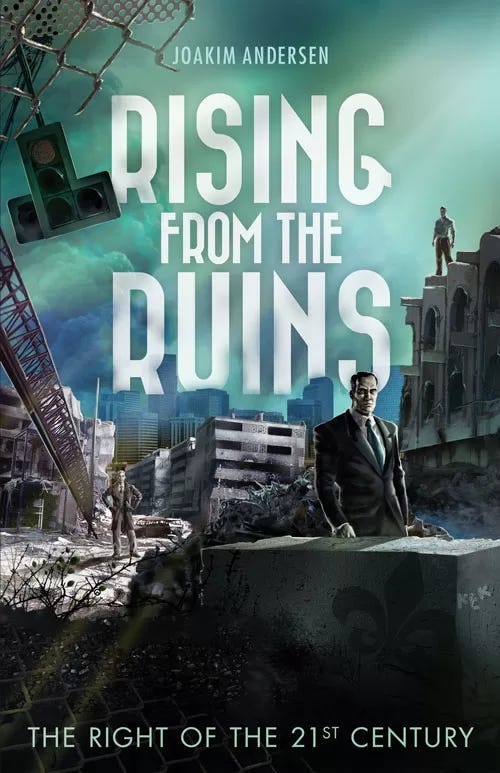The Post-Woke Left
By Joakim Andersen
Joakim Andersen argues that while the woke movement may have passed its public peak, it remains entrenched in key institutions and continues to shape left-wing ideology under the guise of populism. He suggests this shift is tactical rather than genuine, preserving woke values within managerial and bureaucratic structures.
It is sometimes said that we have passed “peak woke,” that the woke phenomenon has now reached its peak and, like the tide, is receding. “With the right kind of eyes you can almost see the high‑water mark — that place where the wave finally broke and rolled back,” to quote Hunter S. Thompson’s description of how 1960s culture crashed.
There are many parallels between then and now — for example the left‑wing terror and Afromania described in works such as Days of Rage, and today matched by a new wave of terror and BLM. The same applies to the negative view of laws regarding the age of sexual consent that was widespread on the left in the previous phase but then discreetly placed in the so‑called memory hole.
There are also differences: in the previous wave, there were still civil servant milieux of the classic bourgeois type, but today the managerial layers have for decades been shaped by the left that led into the woke phenomenon; the pre‑woke milieus of the 1960s also had a significant Jewish component, but the situation is more complex today.
History suggests what is going on right now: the woke strata have encountered multiple setbacks, not least the lack of popular support; just as after 1968 they will withdraw and lick their wounds. Internally they will continue to keep their ideas and sentiments alive, and further develop them ahead of the next wave; some of them will radicalize further and punish the people who did not embrace their ideas (compare the Anabaptist Zwaardgeesten, “sword‑minded,” especially the Batenburgers after the fall of Münster).
As can be seen, it is a useful perspective to regard woke from a historical-religious and psychological standpoint: in many respects, we are dealing with a sect (a heresy, or indeed a heresy within a heresy, more precisely the post‑Protestant secularism). The sect has ties to the meta‑historical left that Igor Shafarevich described, but also to the modern state, academia, and the class that has been called, among other names, the managerial class, the bureaucracy, and the PMC [professional-managerial class]. With the modern state we get the prospective managerial strata, intimately linked to the academic world that shapes them. Here we glimpse why Marx spoke so quietly about bureaucracy as a class and instead wanted to tie the left to the working class: the left is the avant‑garde of the managerial strata rather than of the proletariat.
This means that talk of “peak woke” is at once true and false. It is true that this phase has culminated, but the milieux and strata that carry woke sentiments and ideals bide their time, and they staff large parts of what Althusser called the ideological state apparatus (school, academia, media, church, etc.). To assume that we have now won and can rest on our laurels would be to count our chickens before they hatch.
An interesting analysis of how the left will handle woke’s lack of popularity is offered by Carl Benjamin (also known as the YouTuber Sargon of Akkad) in the video essay The Post‑Woke Left: An Examination. Benjamin’s starting point is that the left has realized that woke is unpopular and will tone it down as a strategy, but that they remain woke. This is true especially of their view on immigration as a human right and a necessity to uphold the system. They are in the process of repositioning their rhetoric — from explicit woke to left populism, “the 99% versus the 1%.”
Benjamin observes that the purely economic definition of these two poles does not correspond to people’s own identities and camouflages real conflicts among the 99%. His deeper analysis of the worldview around mass immigration as a right is also interesting. The woke left regards the world outside the West as an inferno from which we must rescue people. At the same time, they regard the West as a nursing home, where we need brown bodies to take care of us; Benjamin here speaks of “the brown man’s burden.”
It also gets interesting when he addresses their view on why there are “bad people”; they argue that poverty and structures lie behind it (though this does not apply when they explain “white racists,” it may be noted). Benjamin’s analysis is in some places unfair — the left’s worldview is not quite as primitive as he asserts (the logic of capital, for example, can explain why some rich people may also be “bad”).
But, as a whole, it is a rewarding analysis; Carl addresses many of their claims about the welfare state’s need for immigration and that it is “the rich” that have raised rents rather than mass immigration. He also claims that it is likely that the old woke left will, for a considerable time for the future, get stuck in a political ghetto with limited popular support. Among their weaknesses are the inability to acknowledge English identity and their unwillingness to reduce immigration. These are also weaknesses that a post‑woke left will have in Sweden; even when it presents itself as left populist, it will carry woke sentiments and ideas which without much difficulty can be drawn out by bourgeois, nationalists, and others who debate it.
Essentially, then, it is not truly post‑woke in the strict sense; it has for tactical reasons toned down an unpopular rhetoric. Also interesting is the relation between post‑woke populism and historical Marxism. It is now more about redistributing and administering, not about changing the relations of production. The left populism on the table is more of a managerial project than an expression of “the working class’s liberation must be won by the working class itself.” The working class is object rather than subject in such a project, even if it is quite possible that “the working class itself” always functioned as rhetoric rather than functioning Realpolitik (the manifesto’s schema for the demise of modes of production may be read as a piece of elite theory, where the transition to socialism falls outside). By now we have noted that Marx not only erred about who the combatants were and missed/obscured bureaucracy, he also misjudged the balance of forces (which the temporal aspect hints at — the first communists believed, like the first Christians, that the world transformation could occur within their own lifetimes). That the managerial strata coordinate according to their interests under a left‑populist guise may therefore be perfectly rational, even if Sahra Wagenknecht shows that left populism need not be woke.
Carl’s analysis of the post‑woke left: The Post‑Woke Left: An Examination:
(Translated from the original Swedish article)





I don't think you can consider "wokeism" as a "Left" perspective at all.
Here are my 2 cents worth anyway: https://www.21cir.com/2023/02/160162/
Nella sinistra il woke è ormai consolidati come un dogma, non verrà mai meno perché altrimenti dovrebbe sconfessare tutte le scelte fatte fin'ora. Serve per tenere in piedi una narrazione che ha permeato tutti i gangli della società moderna. E la sinistra, si sa, è dentro tutti gli apparati delle amministrazioni occidentali.